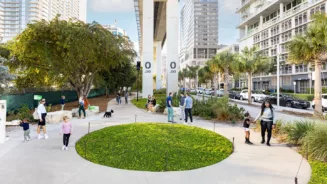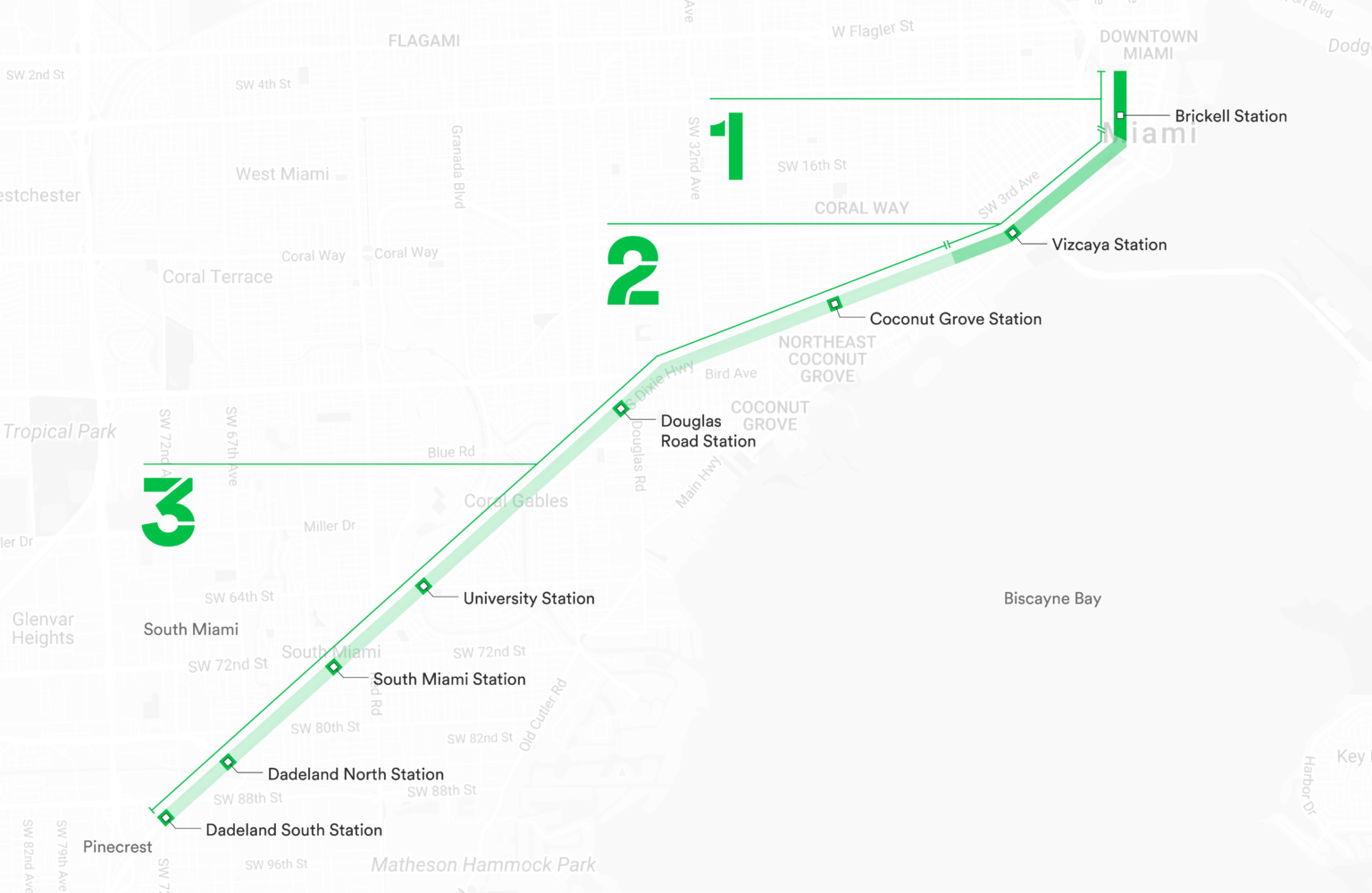A Catalytic Investment in the Future of Miami

1. Introduction
The Underline brings together the best of Miami, with spaces for families and visitors to enjoy the outdoors and engage with the arts year round. This revitalizing project is an example of the opportunities that public-private partnerships can unlock to enrich our communities.
Introduction
As hundreds of visitors began streaming into the first completed stretch of the newly opened The Underline in Miami in the last week of February 2021, they could scarcely believe their eyes.
Here, in a linear park that was quickly becoming known as the “Brickell Backyard,” they could enjoy an area called the River Room, with carefully separated walking and biking paths and a dog walk, all richly landscaped with native flowers, grasses, and trees. They could patronize an outdoor gym with equipment for soccer and basketball and exercise or spend time in the promenade, complete with a plaza for community events, cultural programming, and wellness sessions. Or they could relax in the Oolite Room, featuring four butterfly gardens fitted into a natural stone canyon.
What few of these delighted visitors—coming in from across the city— could have imagined was that it all began with a bike accident.
In 2013, Meg Daly, a sales and marketing executive based in Miami, suffered a serious accident while bicycling around town and broke both her arms, requiring her to spend three months in recovery. Unable to drive, Daly began using the county’s Metrorail to attend physical therapy, making the last leg of the trip on foot below the elevated transit line. Surveying the acres of blighted, unused land beneath the structure, she could not help but wonder, “Why are we not using all this land and turning it into an amenity for the community?”

So was born the idea for The Underline, an innovative 10-mile linear park below the Metrorail that would transform 120 newly reclaimed acres in a combination of urban trail system, reforestation project, recreational and community resource, and art park—an “amazing destination,” in Daly’s words, “to knit our community together.”
A New Kind of Park
The Underline concept draws on one of the most exciting urban developments of the 21st century: the linear park, built on and around former and existing transportation lines. Pioneered by the Promenade Plantée in Paris, the idea gained visibility with the 2009 opening of the High Line, a 30-block-long landscaped open space in Manhattan built atop a former elevated freight-rail structure. Inspired by that project, which quickly became one of the most popular destinations in New York, cities across the country were soon developing versions of their own, transforming hundreds of miles of disused urban rail lines into recreational resources.

For Daly, the need for a similar project was obvious. “Miami was one of the most dangerous places to walk and bike in the country,” she notes, citing the mixed availability of established walking and biking paths in the city. “Our infrastructure has sort of divided us—and now this is using infrastructure to connect us. This is a focus on multimodal mobility, so people have options on how to get around safely.”
As a marketing expert, Daly understood that the best way to bring the idea to life would be to reach out to potential supporters, build a movement, and mobilize the community. To help visualize the concept, she approached leaders of the University of Miami’s architecture program, who agreed to conduct a design studio on the project, resulting in student renderings to advance the effort.
“It was trying to get this big ‘yes’—a lot of times that’s very hard to do because people are used to saying ‘no.’ There was a lot of excitement and enthusiasm, and the speed of delivery has kept the energy going.”
A key step was gaining the support of Miami-Dade County, on whose land the Metrorail was built. Daly and her colleagues made the simple but compelling argument that a park beneath the train line would actually be a bargain of sorts, since its contiguous right of way was already in public hands, and thus represented $60 million that did not have to be spent on land acquisition.
Working with James Corner Field Operations, the New York landscape architecture firm that had designed the High Line, Daly and her team began preparing a master plan. “All of our public meetings have been done in three languages: English, Spanish, and Creole,” she notes, “and we listen first before we design. The master plan was sort of this broad stroke of possibility, and then you have the reality of funding. We had to be true to the priorities of the community, which was safety first, nature second, community activities and everything else third.”

Many Spaces for Many Needs
As it evolved, the plan represented a series of layers of purpose and use. At its foundation was transportation—safe routes for people to walk, bike, and scooter—connected to eight transit stations linked to the “city-at-large”. No less important was the provision of 34 secure pedestrian intersections throughout the park to knit together the once-disconnected communities on either side.
The next layer was nature. Where natural features had once been stripped out to build the Metrorail, a process of reforestation is now bringing 500,000 new native plants and trees to the park, along with a necklace of bioswales—landscaped depressions that capture stormwater runoff—to mitigate flooding during tropical storms.

The third layer was the extensive program of activities, many focused on health and wellness—from outdoor gyms and flex courts to nature-inspired playgrounds, skate parks, and pickleball courts. There would be dog runs, an outdoor stage for events, farmers’ markets, and food and beverage amenities.
Not least, The Underline would function as a 10-mile-long art park, filled with temporary and permanent art installations and would offer its visitors free Wi-Fi—a crucial amenity, building on Griffin Catalyst’s support for Miami Connected, with the goal of bridging the digital divide in a city where 30% of households still do not have internet access in their homes.

A Link Across Miami
In 2021, the first half-mile of The Underline, in Downtown Miami, opened to wide acclaim and has since become a major community destination, open 24 hours a day. Shortly after the construction fences came down, the first joggers were spotted utilizing the space.
“It’s amazing!” Daly exclaimed. “People are already just walking on The Underline like it’s always been there.”
The next two-and-a-quarter-miles of the park, soon to be completed, passes mostly through single-family residential neighborhoods, while the remaining seven miles, in advanced planning and on track for completion by 2026, will extend as far south as Coral Gables, home to the University of Miami. When complete, The Underline will pass through four government jurisdictions and dozens of neighborhoods along its 10-mile length—holding the promise of linking together, both physically and socially, the widely diverse communities that make up the Miami metropolitan area.
Funding for The Underline has come from municipal, county, state, and federal sources, with crucial assistance from private philanthropy, including Griffin Catalyst, whose $5 million gift to fund the project’s cycling and pedestrian trails has proved crucial to encouraging additional support from public and private sources.


Today’s groundbreaking is a testament to the power and potential of our community. When we create effective and innovative infrastructure, we empower our communities to thrive.





